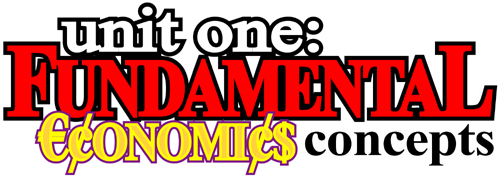Trade-Offs and Opportunity Cost
Economic choices involve trade-offs and the careful
evaluation of opportunity costs.
There are alternatives and costs to everything we do.
In a world where “there is no such thing as a free lunch,” it pays to examine
these concepts closely.
Trade-Offs
Every decision we make has its trade-offs, or alternative
choices. One way to help us make decisions is to construct models
such as the grid shown below. This grid shows how Jessica decides
to spend a $100 gift.
trade-off
alternative that is available whenever a choice is
to be made
Jessica likes several alternatives: a video game, concert
tickets, a game console, and a replica NFL jersey. At the same time,
she realizes that each item has advantages and disadvantages. Some
of the items can be used more than once, and some might require her parents’
consent. Some might even require her to kick in a little extra money.
To help with her decision, Jessica can draw a grid that
lists her alternatives and several criteria by which to judge them.
Then she evaluates each alternative with a “yes” or “no.” In the end, Jessica
chooses the jersey because it satisfies more of her criteria than any other
alternative. Plus, she had money left over.
Using a decision-making grid is one way to analyze an
economic problem. It forces you to consider a number of alternatives
and the criteria you’ll use to evaluate the alternatives. Finally,
it makes you evaluate each alternative based on the criteria you selected.
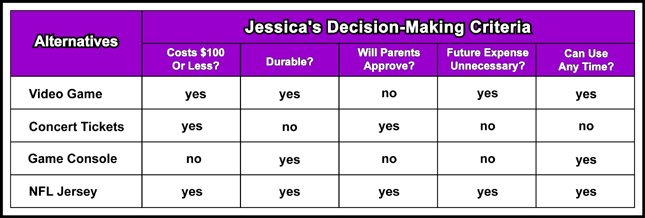
Opportunity Cost
People often think of cost in terms of dollars and cents.
To an economist, however, cost means more than the price tag on a good
or service. Instead, economists think broadly in terms of opportunity
cost, the cost of the next-best alternative. When Jessica decided
to purchase the jersey, her opportunity cost was the video game—the next
best choice she gave up. In contrast, trade-offs are all of the other
alternatives that she could have chosen.
Even time has an opportunity cost, although you cannot
always put a monetary value on it. The opportunity cost of reading
this economics website, for example, the history paper or math homework
that you could not do at the same time.
How are trade-offs and opportunity
cost related?
REVIEW & DO
NOW
Answer the following questions: |
|
|
| What is meant by opportunity cost? |
|
|
|
Production Possibilities
Economies face trade-offs when deciding what goods
and services to produce.
| To illustrate opportunity cost, economists use the production
possibilities frontier, a diagram representing various combinations
of goods and services an economy can produce when all its resources are
in use. In the example on the right, a mythical mega-corporation
called the Alpha Corporation produces two goods for the country—guns and
butter. |
|
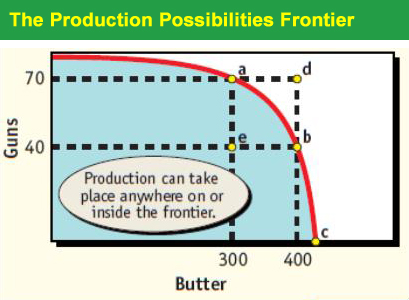 |
production possibilities frontier diagram
representing the maximum combinations of goods and/or
services an economy can produce when all productive resources are fully
employed
Identifying Possible Alternatives
Even though Alpha produces only two goods, the country
has a number of
alternatives available to it. For example, it could
choose to use all of its resources to produce 70 units of guns and 300
units of butter, which is shown as point a in the Production Possibilities
Frontier diagram. Or it could shift some of its resources out of
gun production and into butter, thereby moving to point b.
Alpha could even choose to produce at point c, which represents
all butter and no guns, or at point e, which is inside the frontier.
Alpha has many alternatives available to it, which is
why the figure is called a production “possibilities” frontier. Eventually,
though, Alpha will have to settle on a single combination such as point
a,
b, or any other point on or inside the curve, because its resources
are limited.
Fully Employed Resources
All points on the curve such as a, b, and
c
represent maximum combinations of output that are possible if all resources
are fully employed. To illustrate, suppose that Alpha is producing
at point a, and the people would like to move to point d,
which represents the same amount of guns, but more butter. As long
as all resources are fully employed at point a, there are no extra
resources available to produce the extra butter. Therefore,
point
d cannot be reached, nor can any other point outside the curve.
This is why the figure is called a production possibilities “frontier”—to
indicate the maximum combinations of goods and services that can be produced.
The Cost of Idle Resources
If some resources were not fully employed, then it would
be impossible for the Alpha Corporation to reach its maximum potential
production. Suppose that Alpha was producing at point b when
workers in the butter industry went on strike. Butter production
would fall, causing total output to change to point e. The
opportunity cost of the unemployed resources would be the 100 units of
lost butter production.
Production at point e could also be the result
of other idle resources, such as factories or land that are available but
not being used. As long as some resources are idle, the corporation
cannot produce on its frontier—which is another way of saying that it cannot
reach its full production potential.
Opportunity Cost
| Suppose that the Alpha Corporation was producing at point
a and that it wanted to move to point b. This is clearly
possible as long as point b is not outside the production possibilities
frontier. However, Alpha will have to give something up in return.
As shown on the right, the opportunity cost of producing the 100 additional
units of butter is the 30 units of guns given up. |
|
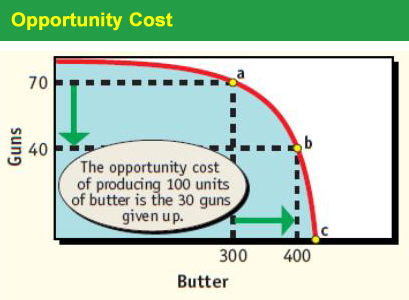 |
As you can see, opportunity cost applies to almost
all activities, and it is not always measured in terms of dollars and cents.
For example, you need to balance the time you spend doing homework and
the time you spend with your friends. If you decide to spend extra
hours on your homework, the opportunity cost of this action is the time
that you cannot spend with your friends. You normally have a number
of trade-offs available whenever you make a decision, and the opportunity
cost of the choice you make is the value of the next best alternative that
you give up.
Economic Growth
The production possibilities frontier represents potential
output at a given point in time. Eventually, however, changes may
cause the production possibilities frontier to expand. The population
may grow, the stock of capital may expand, technology may improve, or productivity
may increase. If any of these changes occur, then the Alpha Corporation
will be able to produce more in the future.
| The effect of economic growth in the economy or in industry
is shown in the diagram on the right. Economic growth, made possible
by having more resources, better technology, or increased productivity,
causes the production possibilities frontier to move outward. Economic
growth will eventually allow the Alpha Corporation to produce both guns
and butter at point d, which it could not do earlier. |
|
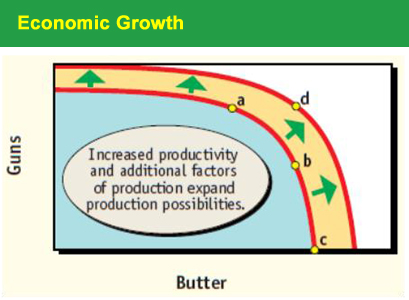 |
How can the production possibilities
frontier be used to illustrate economic growth?
REVIEW & DO
NOW
Answer the following questions: |
| What is a production possibilities frontier diagram? |
|
|
|
|
Thinking Like an Economist
Economists use a strategy called cost-benefit analysis
to evaluate choices.
Because economists study how people satisfy seemingly
unlimited and competing wants through the careful use of scarce resources,
they are concerned with strategies that will help people make the best
choices. Two strategies are building models and preparing a cost-benefit
analysis.
Build Simple Models
One of the most important strategies is to build economic
models. An economic model is a simplified equation, graph,
or figure showing how something works. Simple models can often reduce
complex situations to their most basic elements. To illustrate, the
production possibility frontiers in this section and the circular flow
diagram below are examples of how complex economic activity can be explained
by a simple model.
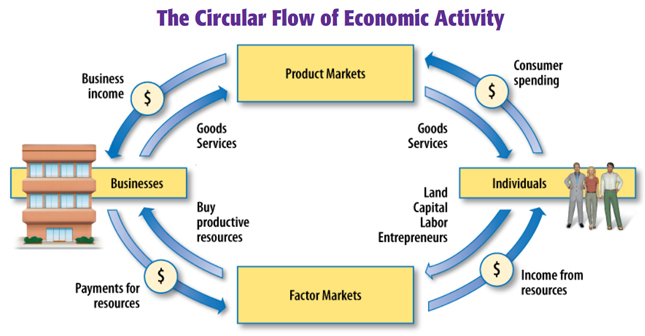
economic model
simplified version of a complex concept or behavior
expressed in the form of an equation, graph, or illustration
.
| Another basic model is the production possibilities frontier
shown on the right. Realistically, of course, economies are able
to produce more than two goods or services, but the concepts of trade-offs
and opportunity costs are easier to illustrate if only two products are
examined. As a result, simple models such as these are sometimes
all that economists need to analyze or describe an actual situation. |
|
 |
It is important to realize that models are based on assumptions,
or things we think are true. In general, the quality of a model is
no better than the assumptions on which it is based, but a model with simple
assumptions is usually easier to understand. In the case of the production
possibilities frontier, for example, we assumed that only two goods could
be produced. This made the model easier to illustrate and still allowed
us to discuss the concepts of trade-offs and opportunity costs.
It is also important to keep in mind that models can be
revised to make them better. If an economic model helps us to make
a prediction that turns out to be right, the model can be used again.
If the prediction is wrong, the model might be changed to make better predictions
the next time.
Apply Cost-Benefit Analysis
Most economic decisions can be evaluated with cost-benefit
analysis, a way of comparing the costs of an action to the benefits
received. This is what Jesse did when he devised a decision-making
grid. This decision can be made subjectively, as when Jesse selected
the jersey, or it can be made more objectively, especially if the costs
of the various alternatives are different.
cost-benefit
analysis way of thinking about a choice that compares
the cost of an action to its benefits
To illustrate, suppose that you have to make a decision,
and you like choices A and B equally. If B costs less, it would be
the better choice because you would get more satisfaction per dollar spent.
Businesses make investment decisions in exactly this manner, choosing to
invest in projects that give the highest return per dollar spent or, in
other words, the best cost-benefit ratio.
Take Small, Incremental Steps
Finally, it also helps to take small, incremental steps
toward the final goal. This is especially valuable when we are unsure
of the exact cost involved. If the cost turns out to be larger than
we anticipated, then the resulting decision can be reversed without too
much being lost.
How does cost-benefit analysis
help make economic decisions?
REVIEW & DO
NOW
Answer the following questions: |
| What are economic models? |
|
| What is a cost-benefit analysis? |
|
|
|
The Road Ahead
The study of economics helps people become better
citizens.
The study of economics does more than explain how people
deal with scarcity. Economics also includes the study of how things
are made, bought, sold, and used. It provides insight as to how incomes
are earned and spent, how jobs are created, and how the economy works on
a daily basis. The study of economics also gives us a better understanding
of the workings of a free enterprise economy—one in which consumers
and privately owned businesses, rather than the government, make the majority
of the WHAT, HOW, and FOR WHOM decisions.
free enterprise economy
economy market economy in which privately owned businesses
have the freedom to operate for a profit with limited government intervention
Topics and Issues
The study of economics will provide you with a working
knowledge of the economic incentives, laws of supply and demand, price
system, economic institutions, and property rights that make the U.S.
economy function. Along the way, you will learn about topics such
as unemployment, the business cycle, inflation, and economic growth.
You will also examine the role of business, labor, and government in the
U.S. economy, as well as the relationship of the United States economy
with the international community.
All of these topics have a bearing on our standard
of living—the quality of life based on the ownership of the necessities
and luxuries that make life easier. As you study economics, you will
learn how to measure the value of our production and how productivity helps
determine our standard of living. You will find, however, that the
way the American people make economic decisions is not the only way to
make these decisions.
standard of living
quality of life based on ownership of necessities
and luxuries that make life easier
Economists have identified three basic kinds of economic
systems. We will analyze these systems and how their organization
affects decision making in the next chapter.
Economics for Citizenship
The study of economics helps us become better decision
makers—in our personal lives as well as in the voting booths. Economic
issues are often debated during political campaigns, so we need to understand
the issues before deciding which candidate to support.
Most of today’s political problems have important economic
aspects. For example, is it important to balance the federal budget?
How can we best keep inflation in check? What methods can we use to strengthen
our economy? The study of economics will not provide you with clear-cut
answers to all of these questions, but it will give you a better understanding
of the issues involved.
Understanding the World Around
Us
The study of economics helps us understand the complex
world around us. This is particularly useful because the world is
not as orderly as your economics textbook, for example. Your book
is neatly divided into sections for study. In contrast, society is
dynamic, and technology and other innovations always lead to changes.
Economics provides a framework for analysis—a structure
that helps explain how things are organized. Because this framework
describes the incentives that influence behavior, it helps us understand
why and how the world changes.
In practice, the world of economics is complex and the
road ahead is bumpy. As we study economics, however, we will gain
a much better appreciation of how we affect the world and how it affects
us.
How do you think our society
would be different if citizens did not study economics?
REVIEW & DO
NOW
Answer the following questions: |
| What is a free market economy? |
|
| What is meant by standard of living? |
|
|
|
|

